Auditing Report: Ethical Principles, Independence, and Procedures
VerifiedAdded on 2022/12/28
|13
|3854
|37
Report
AI Summary
This report delves into the critical aspects of auditing, focusing on ethical principles and auditor independence. It examines factors influencing auditor quality, such as source credibility, verifiability of documents, technical procedures, and auditor knowledge. The report analyzes scenarios impacting auditor independence, including financial interests, fee structures, and loan relationships, highlighting potential threats and ethical implications. It explores the concept of objectivity in auditing, differentiating between internal and external audits, and identifying threats to objectivity. The report outlines procedures for handling uncorrected inventory misstatements and assesses indicators of a company's going concern status, along with the procedures auditors should follow. The analysis covers various ethical considerations, procedures, and risks associated with financial statement audits, providing a comprehensive overview of best practices and potential challenges in the field.
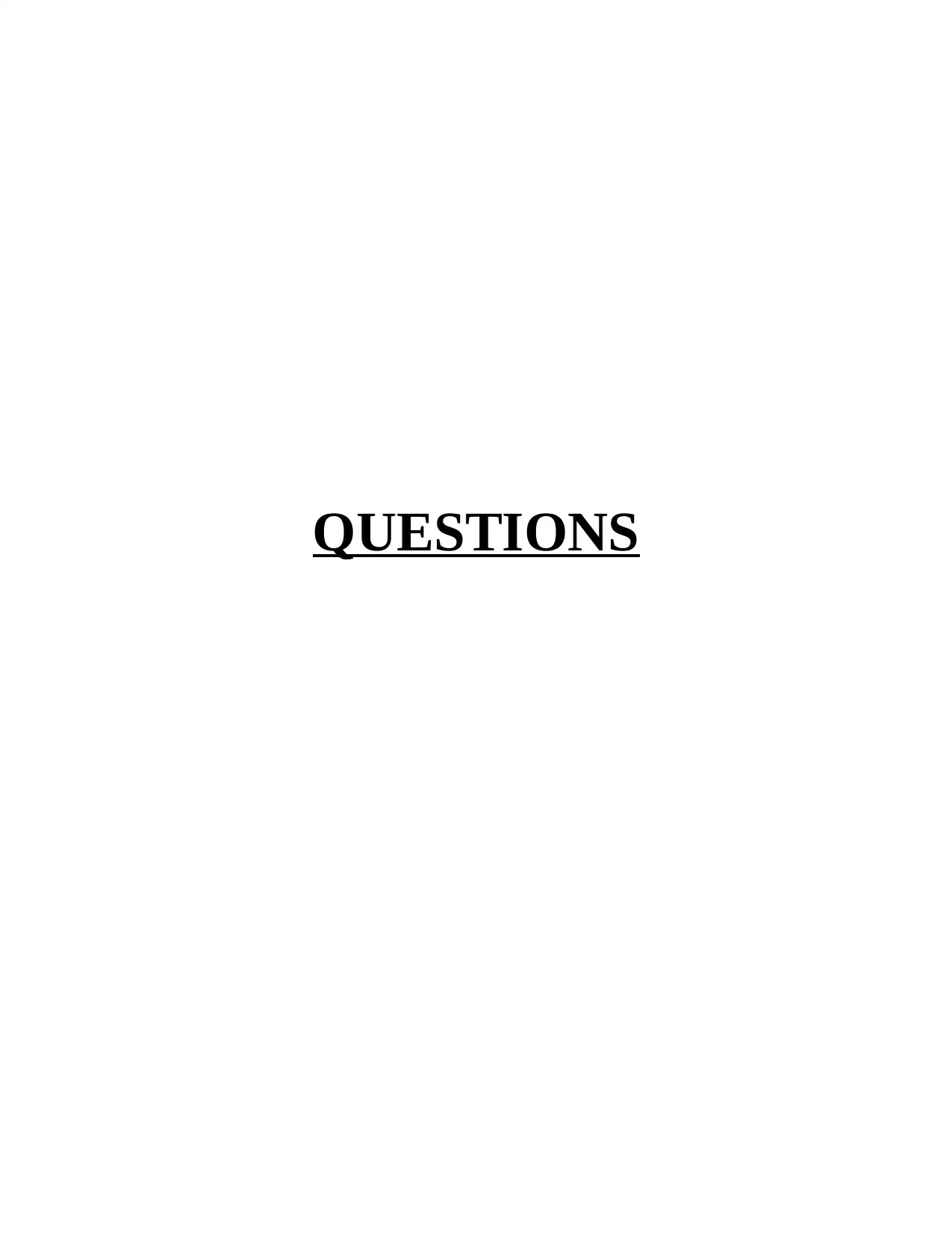
QUESTIONS
Paraphrase This Document
Need a fresh take? Get an instant paraphrase of this document with our AI Paraphraser
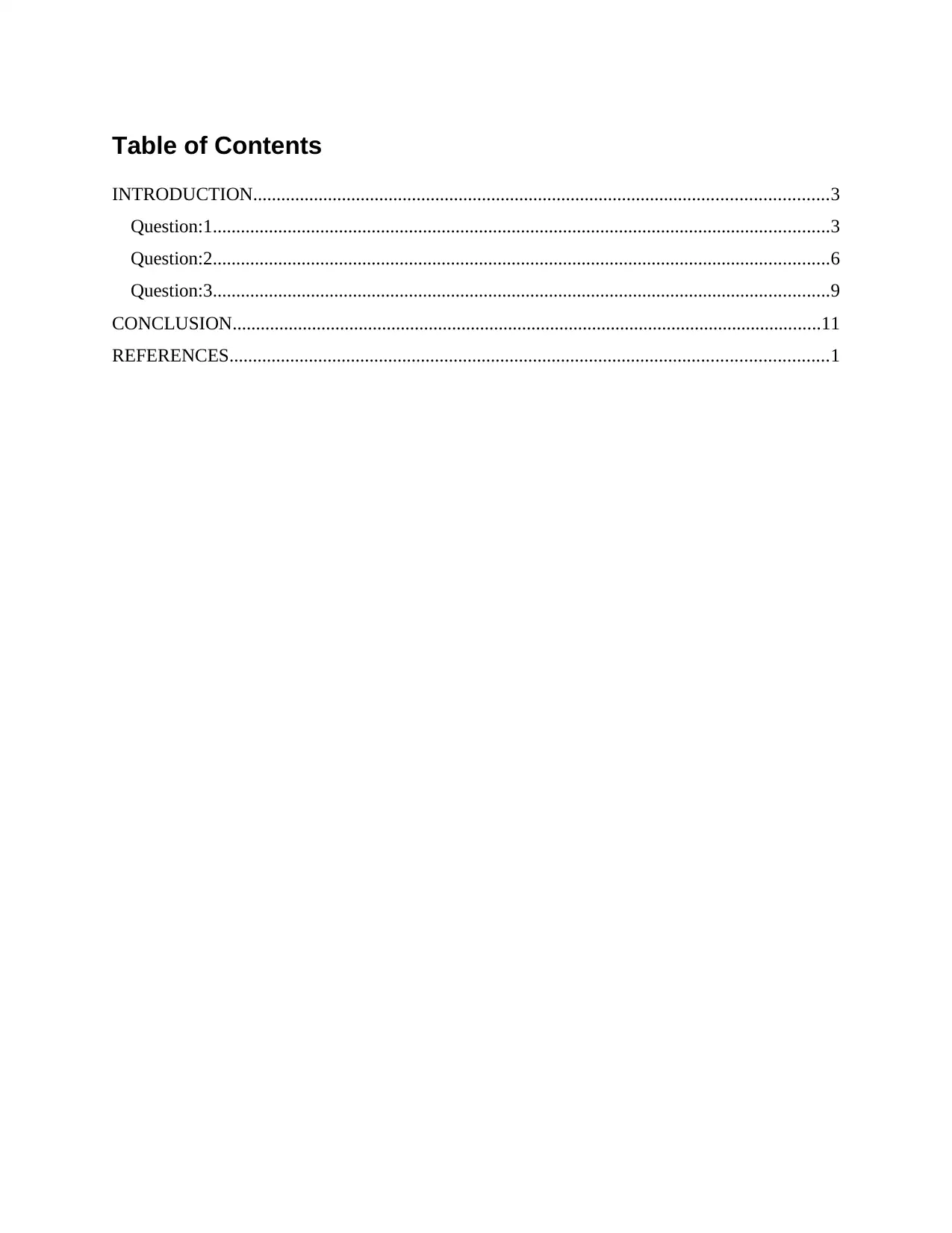
Table of Contents
INTRODUCTION...........................................................................................................................3
Question:1....................................................................................................................................3
Question:2....................................................................................................................................6
Question:3....................................................................................................................................9
CONCLUSION..............................................................................................................................11
REFERENCES................................................................................................................................1
INTRODUCTION...........................................................................................................................3
Question:1....................................................................................................................................3
Question:2....................................................................................................................................6
Question:3....................................................................................................................................9
CONCLUSION..............................................................................................................................11
REFERENCES................................................................................................................................1
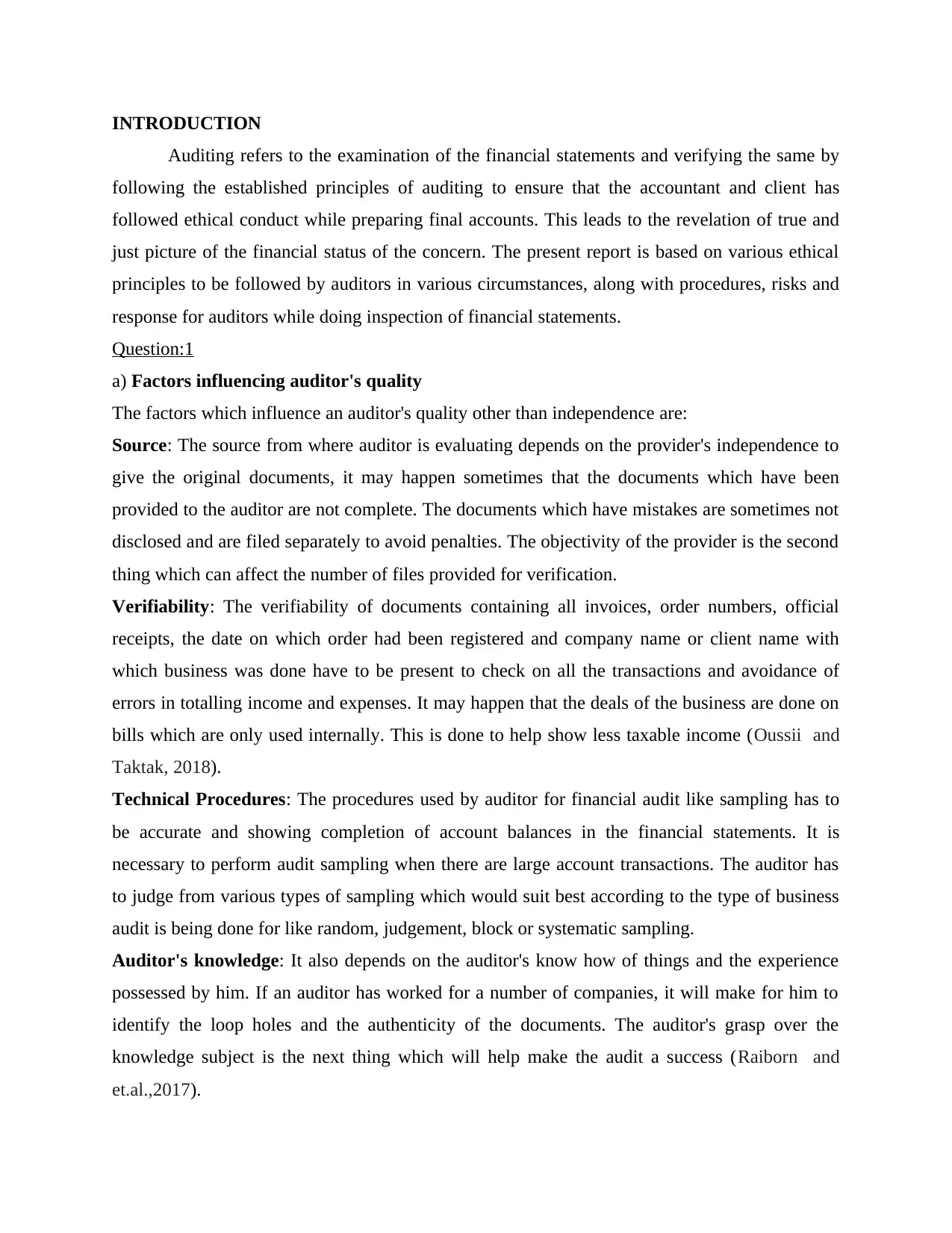
INTRODUCTION
Auditing refers to the examination of the financial statements and verifying the same by
following the established principles of auditing to ensure that the accountant and client has
followed ethical conduct while preparing final accounts. This leads to the revelation of true and
just picture of the financial status of the concern. The present report is based on various ethical
principles to be followed by auditors in various circumstances, along with procedures, risks and
response for auditors while doing inspection of financial statements.
Question:1
a) Factors influencing auditor's quality
The factors which influence an auditor's quality other than independence are:
Source: The source from where auditor is evaluating depends on the provider's independence to
give the original documents, it may happen sometimes that the documents which have been
provided to the auditor are not complete. The documents which have mistakes are sometimes not
disclosed and are filed separately to avoid penalties. The objectivity of the provider is the second
thing which can affect the number of files provided for verification.
Verifiability: The verifiability of documents containing all invoices, order numbers, official
receipts, the date on which order had been registered and company name or client name with
which business was done have to be present to check on all the transactions and avoidance of
errors in totalling income and expenses. It may happen that the deals of the business are done on
bills which are only used internally. This is done to help show less taxable income (Oussii and
Taktak, 2018).
Technical Procedures: The procedures used by auditor for financial audit like sampling has to
be accurate and showing completion of account balances in the financial statements. It is
necessary to perform audit sampling when there are large account transactions. The auditor has
to judge from various types of sampling which would suit best according to the type of business
audit is being done for like random, judgement, block or systematic sampling.
Auditor's knowledge: It also depends on the auditor's know how of things and the experience
possessed by him. If an auditor has worked for a number of companies, it will make for him to
identify the loop holes and the authenticity of the documents. The auditor's grasp over the
knowledge subject is the next thing which will help make the audit a success (Raiborn and
et.al.,2017).
Auditing refers to the examination of the financial statements and verifying the same by
following the established principles of auditing to ensure that the accountant and client has
followed ethical conduct while preparing final accounts. This leads to the revelation of true and
just picture of the financial status of the concern. The present report is based on various ethical
principles to be followed by auditors in various circumstances, along with procedures, risks and
response for auditors while doing inspection of financial statements.
Question:1
a) Factors influencing auditor's quality
The factors which influence an auditor's quality other than independence are:
Source: The source from where auditor is evaluating depends on the provider's independence to
give the original documents, it may happen sometimes that the documents which have been
provided to the auditor are not complete. The documents which have mistakes are sometimes not
disclosed and are filed separately to avoid penalties. The objectivity of the provider is the second
thing which can affect the number of files provided for verification.
Verifiability: The verifiability of documents containing all invoices, order numbers, official
receipts, the date on which order had been registered and company name or client name with
which business was done have to be present to check on all the transactions and avoidance of
errors in totalling income and expenses. It may happen that the deals of the business are done on
bills which are only used internally. This is done to help show less taxable income (Oussii and
Taktak, 2018).
Technical Procedures: The procedures used by auditor for financial audit like sampling has to
be accurate and showing completion of account balances in the financial statements. It is
necessary to perform audit sampling when there are large account transactions. The auditor has
to judge from various types of sampling which would suit best according to the type of business
audit is being done for like random, judgement, block or systematic sampling.
Auditor's knowledge: It also depends on the auditor's know how of things and the experience
possessed by him. If an auditor has worked for a number of companies, it will make for him to
identify the loop holes and the authenticity of the documents. The auditor's grasp over the
knowledge subject is the next thing which will help make the audit a success (Raiborn and
et.al.,2017).
⊘ This is a preview!⊘
Do you want full access?
Subscribe today to unlock all pages.

Trusted by 1+ million students worldwide
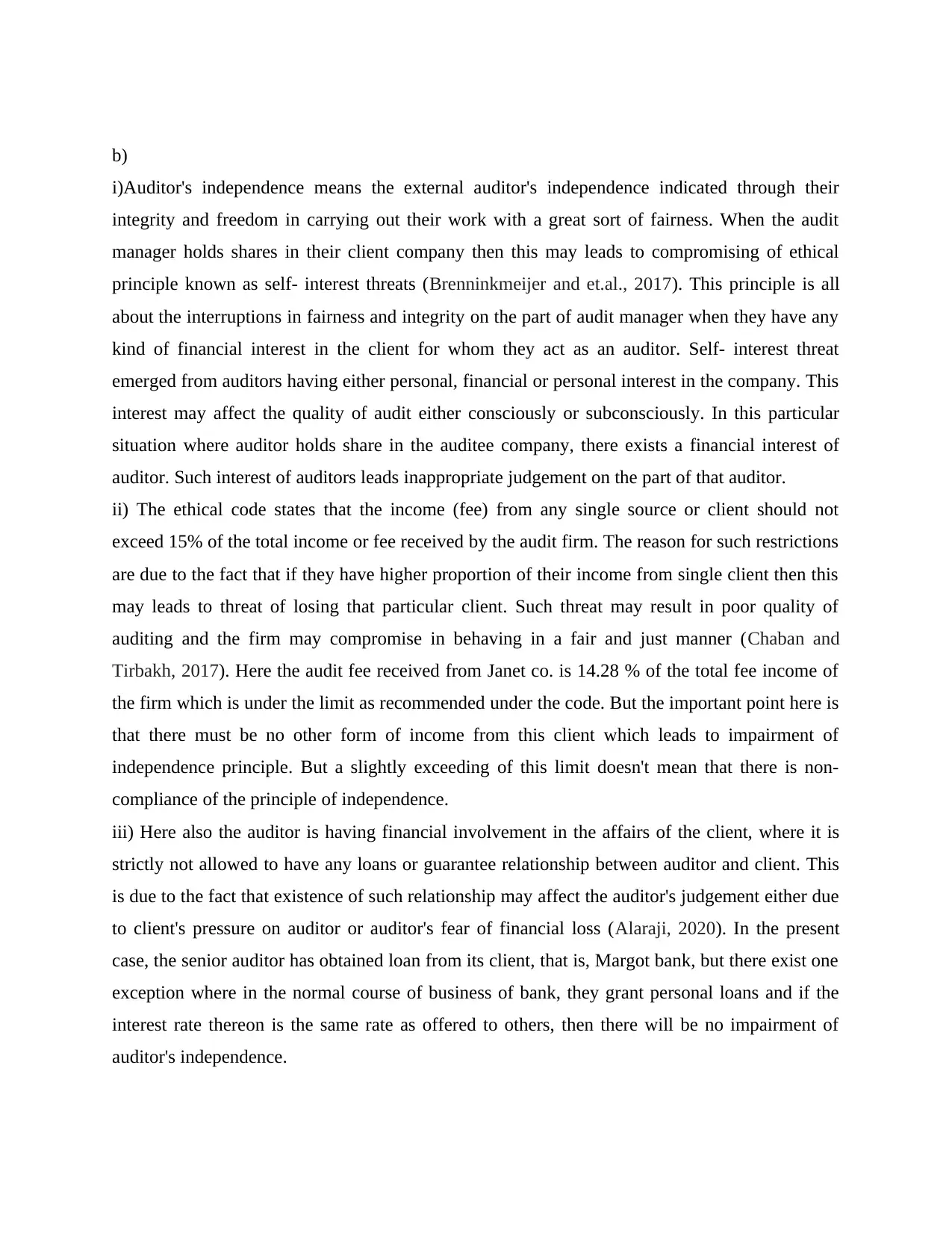
b)
i)Auditor's independence means the external auditor's independence indicated through their
integrity and freedom in carrying out their work with a great sort of fairness. When the audit
manager holds shares in their client company then this may leads to compromising of ethical
principle known as self- interest threats (Brenninkmeijer and et.al., 2017). This principle is all
about the interruptions in fairness and integrity on the part of audit manager when they have any
kind of financial interest in the client for whom they act as an auditor. Self- interest threat
emerged from auditors having either personal, financial or personal interest in the company. This
interest may affect the quality of audit either consciously or subconsciously. In this particular
situation where auditor holds share in the auditee company, there exists a financial interest of
auditor. Such interest of auditors leads inappropriate judgement on the part of that auditor.
ii) The ethical code states that the income (fee) from any single source or client should not
exceed 15% of the total income or fee received by the audit firm. The reason for such restrictions
are due to the fact that if they have higher proportion of their income from single client then this
may leads to threat of losing that particular client. Such threat may result in poor quality of
auditing and the firm may compromise in behaving in a fair and just manner (Chaban and
Tirbakh, 2017). Here the audit fee received from Janet co. is 14.28 % of the total fee income of
the firm which is under the limit as recommended under the code. But the important point here is
that there must be no other form of income from this client which leads to impairment of
independence principle. But a slightly exceeding of this limit doesn't mean that there is non-
compliance of the principle of independence.
iii) Here also the auditor is having financial involvement in the affairs of the client, where it is
strictly not allowed to have any loans or guarantee relationship between auditor and client. This
is due to the fact that existence of such relationship may affect the auditor's judgement either due
to client's pressure on auditor or auditor's fear of financial loss (Alaraji, 2020). In the present
case, the senior auditor has obtained loan from its client, that is, Margot bank, but there exist one
exception where in the normal course of business of bank, they grant personal loans and if the
interest rate thereon is the same rate as offered to others, then there will be no impairment of
auditor's independence.
i)Auditor's independence means the external auditor's independence indicated through their
integrity and freedom in carrying out their work with a great sort of fairness. When the audit
manager holds shares in their client company then this may leads to compromising of ethical
principle known as self- interest threats (Brenninkmeijer and et.al., 2017). This principle is all
about the interruptions in fairness and integrity on the part of audit manager when they have any
kind of financial interest in the client for whom they act as an auditor. Self- interest threat
emerged from auditors having either personal, financial or personal interest in the company. This
interest may affect the quality of audit either consciously or subconsciously. In this particular
situation where auditor holds share in the auditee company, there exists a financial interest of
auditor. Such interest of auditors leads inappropriate judgement on the part of that auditor.
ii) The ethical code states that the income (fee) from any single source or client should not
exceed 15% of the total income or fee received by the audit firm. The reason for such restrictions
are due to the fact that if they have higher proportion of their income from single client then this
may leads to threat of losing that particular client. Such threat may result in poor quality of
auditing and the firm may compromise in behaving in a fair and just manner (Chaban and
Tirbakh, 2017). Here the audit fee received from Janet co. is 14.28 % of the total fee income of
the firm which is under the limit as recommended under the code. But the important point here is
that there must be no other form of income from this client which leads to impairment of
independence principle. But a slightly exceeding of this limit doesn't mean that there is non-
compliance of the principle of independence.
iii) Here also the auditor is having financial involvement in the affairs of the client, where it is
strictly not allowed to have any loans or guarantee relationship between auditor and client. This
is due to the fact that existence of such relationship may affect the auditor's judgement either due
to client's pressure on auditor or auditor's fear of financial loss (Alaraji, 2020). In the present
case, the senior auditor has obtained loan from its client, that is, Margot bank, but there exist one
exception where in the normal course of business of bank, they grant personal loans and if the
interest rate thereon is the same rate as offered to others, then there will be no impairment of
auditor's independence.
Paraphrase This Document
Need a fresh take? Get an instant paraphrase of this document with our AI Paraphraser
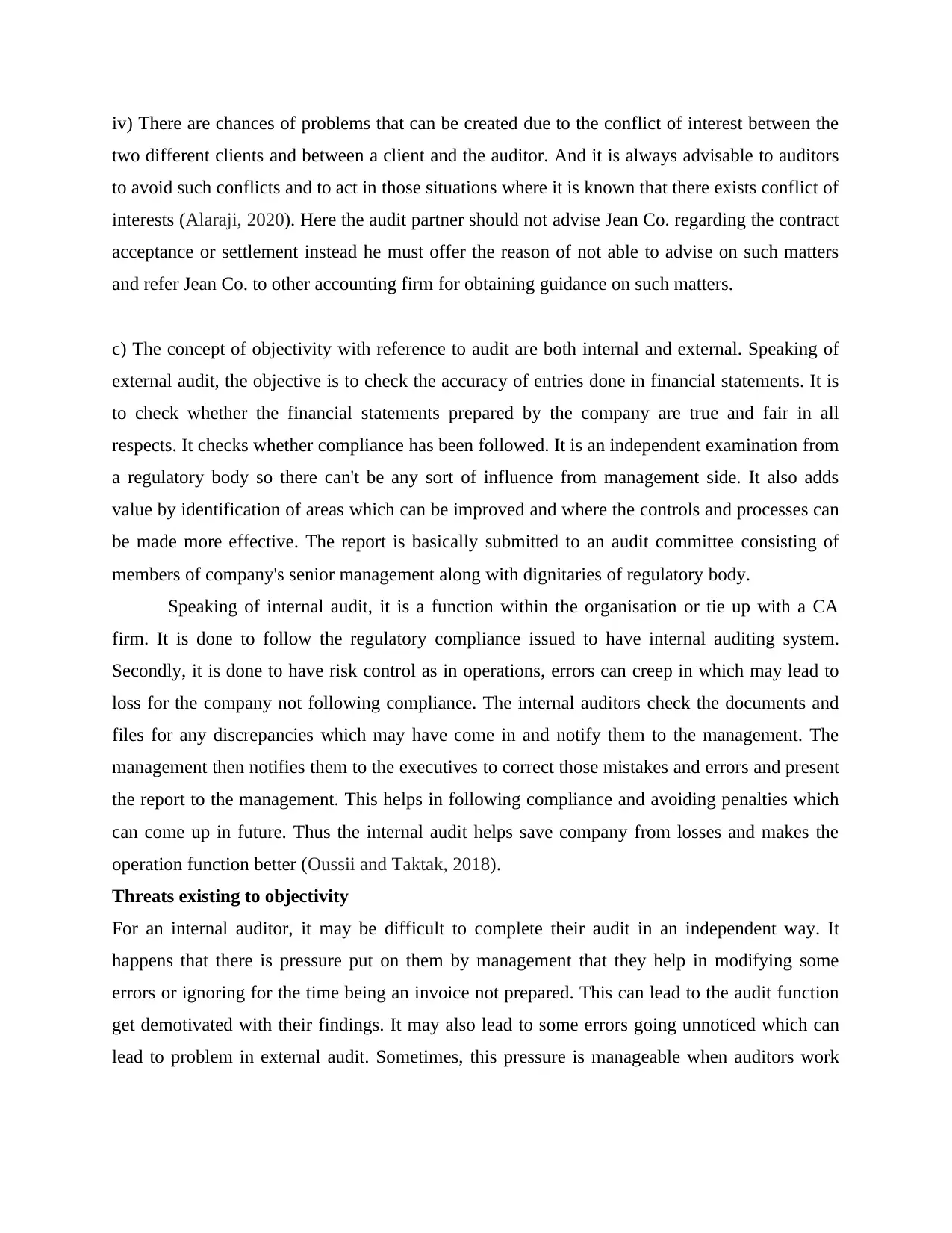
iv) There are chances of problems that can be created due to the conflict of interest between the
two different clients and between a client and the auditor. And it is always advisable to auditors
to avoid such conflicts and to act in those situations where it is known that there exists conflict of
interests (Alaraji, 2020). Here the audit partner should not advise Jean Co. regarding the contract
acceptance or settlement instead he must offer the reason of not able to advise on such matters
and refer Jean Co. to other accounting firm for obtaining guidance on such matters.
c) The concept of objectivity with reference to audit are both internal and external. Speaking of
external audit, the objective is to check the accuracy of entries done in financial statements. It is
to check whether the financial statements prepared by the company are true and fair in all
respects. It checks whether compliance has been followed. It is an independent examination from
a regulatory body so there can't be any sort of influence from management side. It also adds
value by identification of areas which can be improved and where the controls and processes can
be made more effective. The report is basically submitted to an audit committee consisting of
members of company's senior management along with dignitaries of regulatory body.
Speaking of internal audit, it is a function within the organisation or tie up with a CA
firm. It is done to follow the regulatory compliance issued to have internal auditing system.
Secondly, it is done to have risk control as in operations, errors can creep in which may lead to
loss for the company not following compliance. The internal auditors check the documents and
files for any discrepancies which may have come in and notify them to the management. The
management then notifies them to the executives to correct those mistakes and errors and present
the report to the management. This helps in following compliance and avoiding penalties which
can come up in future. Thus the internal audit helps save company from losses and makes the
operation function better (Oussii and Taktak, 2018).
Threats existing to objectivity
For an internal auditor, it may be difficult to complete their audit in an independent way. It
happens that there is pressure put on them by management that they help in modifying some
errors or ignoring for the time being an invoice not prepared. This can lead to the audit function
get demotivated with their findings. It may also lead to some errors going unnoticed which can
lead to problem in external audit. Sometimes, this pressure is manageable when auditors work
two different clients and between a client and the auditor. And it is always advisable to auditors
to avoid such conflicts and to act in those situations where it is known that there exists conflict of
interests (Alaraji, 2020). Here the audit partner should not advise Jean Co. regarding the contract
acceptance or settlement instead he must offer the reason of not able to advise on such matters
and refer Jean Co. to other accounting firm for obtaining guidance on such matters.
c) The concept of objectivity with reference to audit are both internal and external. Speaking of
external audit, the objective is to check the accuracy of entries done in financial statements. It is
to check whether the financial statements prepared by the company are true and fair in all
respects. It checks whether compliance has been followed. It is an independent examination from
a regulatory body so there can't be any sort of influence from management side. It also adds
value by identification of areas which can be improved and where the controls and processes can
be made more effective. The report is basically submitted to an audit committee consisting of
members of company's senior management along with dignitaries of regulatory body.
Speaking of internal audit, it is a function within the organisation or tie up with a CA
firm. It is done to follow the regulatory compliance issued to have internal auditing system.
Secondly, it is done to have risk control as in operations, errors can creep in which may lead to
loss for the company not following compliance. The internal auditors check the documents and
files for any discrepancies which may have come in and notify them to the management. The
management then notifies them to the executives to correct those mistakes and errors and present
the report to the management. This helps in following compliance and avoiding penalties which
can come up in future. Thus the internal audit helps save company from losses and makes the
operation function better (Oussii and Taktak, 2018).
Threats existing to objectivity
For an internal auditor, it may be difficult to complete their audit in an independent way. It
happens that there is pressure put on them by management that they help in modifying some
errors or ignoring for the time being an invoice not prepared. This can lead to the audit function
get demotivated with their findings. It may also lead to some errors going unnoticed which can
lead to problem in external audit. Sometimes, this pressure is manageable when auditors work
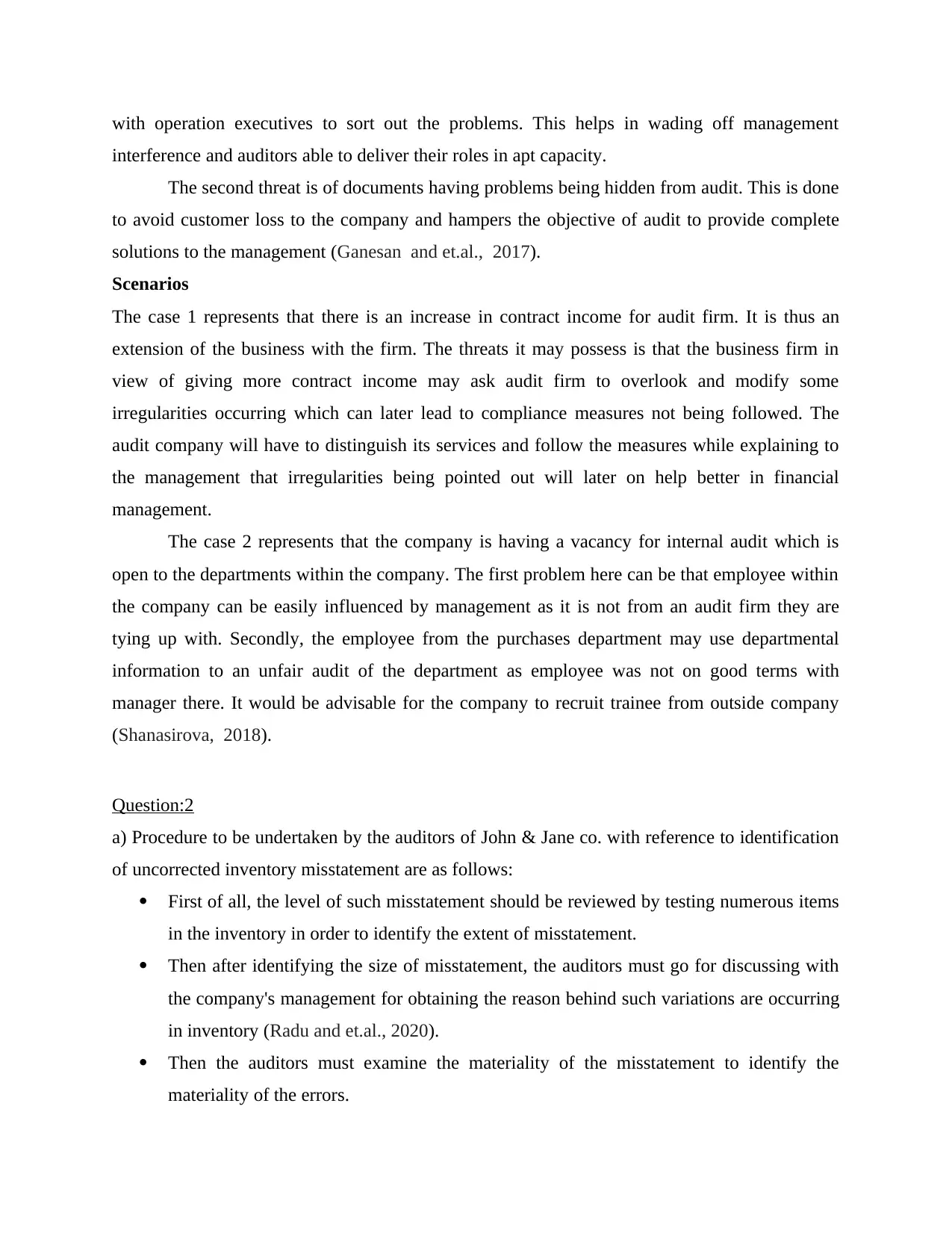
with operation executives to sort out the problems. This helps in wading off management
interference and auditors able to deliver their roles in apt capacity.
The second threat is of documents having problems being hidden from audit. This is done
to avoid customer loss to the company and hampers the objective of audit to provide complete
solutions to the management (Ganesan and et.al., 2017).
Scenarios
The case 1 represents that there is an increase in contract income for audit firm. It is thus an
extension of the business with the firm. The threats it may possess is that the business firm in
view of giving more contract income may ask audit firm to overlook and modify some
irregularities occurring which can later lead to compliance measures not being followed. The
audit company will have to distinguish its services and follow the measures while explaining to
the management that irregularities being pointed out will later on help better in financial
management.
The case 2 represents that the company is having a vacancy for internal audit which is
open to the departments within the company. The first problem here can be that employee within
the company can be easily influenced by management as it is not from an audit firm they are
tying up with. Secondly, the employee from the purchases department may use departmental
information to an unfair audit of the department as employee was not on good terms with
manager there. It would be advisable for the company to recruit trainee from outside company
(Shanasirova, 2018).
Question:2
a) Procedure to be undertaken by the auditors of John & Jane co. with reference to identification
of uncorrected inventory misstatement are as follows:
First of all, the level of such misstatement should be reviewed by testing numerous items
in the inventory in order to identify the extent of misstatement.
Then after identifying the size of misstatement, the auditors must go for discussing with
the company's management for obtaining the reason behind such variations are occurring
in inventory (Radu and et.al., 2020).
Then the auditors must examine the materiality of the misstatement to identify the
materiality of the errors.
interference and auditors able to deliver their roles in apt capacity.
The second threat is of documents having problems being hidden from audit. This is done
to avoid customer loss to the company and hampers the objective of audit to provide complete
solutions to the management (Ganesan and et.al., 2017).
Scenarios
The case 1 represents that there is an increase in contract income for audit firm. It is thus an
extension of the business with the firm. The threats it may possess is that the business firm in
view of giving more contract income may ask audit firm to overlook and modify some
irregularities occurring which can later lead to compliance measures not being followed. The
audit company will have to distinguish its services and follow the measures while explaining to
the management that irregularities being pointed out will later on help better in financial
management.
The case 2 represents that the company is having a vacancy for internal audit which is
open to the departments within the company. The first problem here can be that employee within
the company can be easily influenced by management as it is not from an audit firm they are
tying up with. Secondly, the employee from the purchases department may use departmental
information to an unfair audit of the department as employee was not on good terms with
manager there. It would be advisable for the company to recruit trainee from outside company
(Shanasirova, 2018).
Question:2
a) Procedure to be undertaken by the auditors of John & Jane co. with reference to identification
of uncorrected inventory misstatement are as follows:
First of all, the level of such misstatement should be reviewed by testing numerous items
in the inventory in order to identify the extent of misstatement.
Then after identifying the size of misstatement, the auditors must go for discussing with
the company's management for obtaining the reason behind such variations are occurring
in inventory (Radu and et.al., 2020).
Then the auditors must examine the materiality of the misstatement to identify the
materiality of the errors.
⊘ This is a preview!⊘
Do you want full access?
Subscribe today to unlock all pages.

Trusted by 1+ million students worldwide
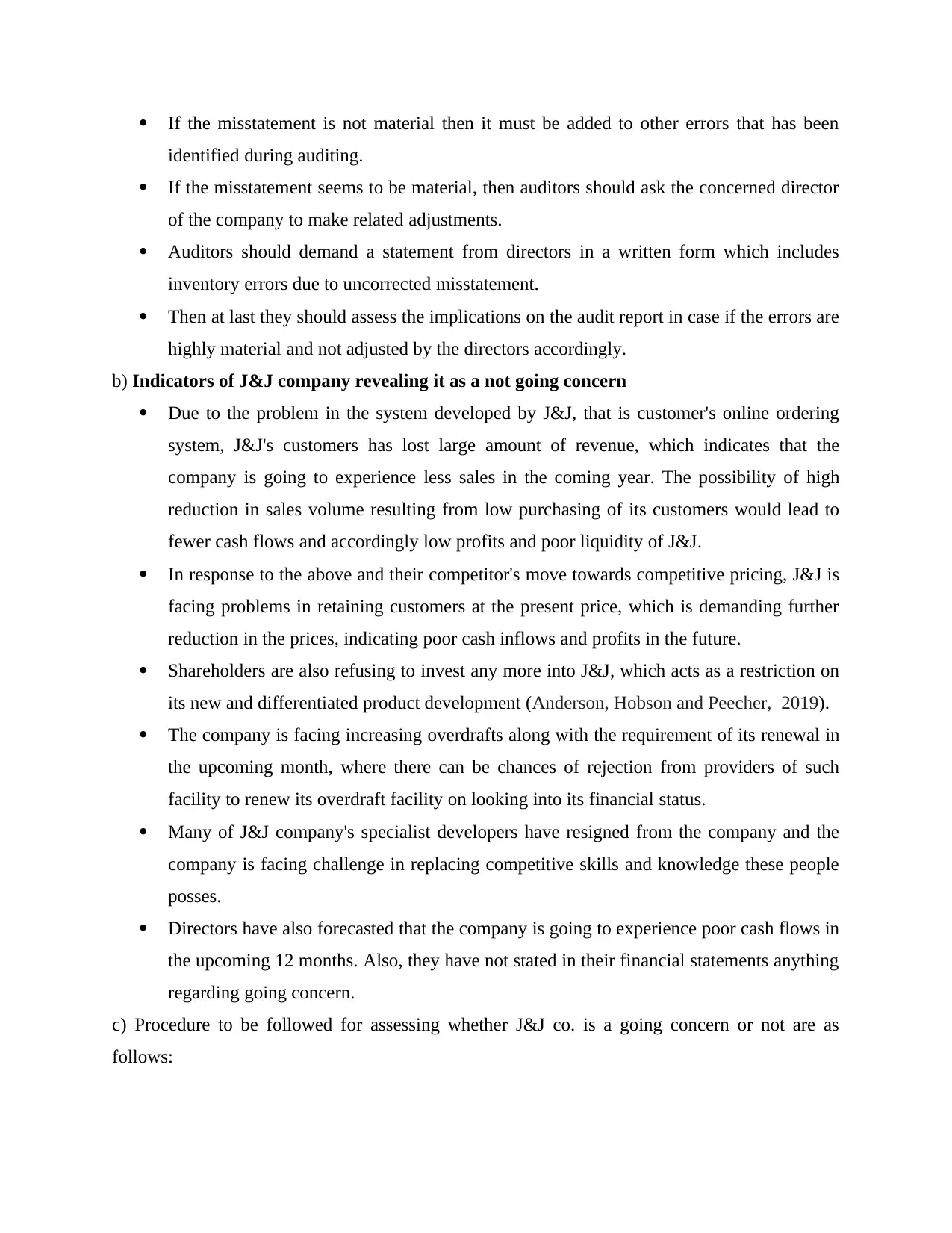
If the misstatement is not material then it must be added to other errors that has been
identified during auditing.
If the misstatement seems to be material, then auditors should ask the concerned director
of the company to make related adjustments.
Auditors should demand a statement from directors in a written form which includes
inventory errors due to uncorrected misstatement.
Then at last they should assess the implications on the audit report in case if the errors are
highly material and not adjusted by the directors accordingly.
b) Indicators of J&J company revealing it as a not going concern
Due to the problem in the system developed by J&J, that is customer's online ordering
system, J&J's customers has lost large amount of revenue, which indicates that the
company is going to experience less sales in the coming year. The possibility of high
reduction in sales volume resulting from low purchasing of its customers would lead to
fewer cash flows and accordingly low profits and poor liquidity of J&J.
In response to the above and their competitor's move towards competitive pricing, J&J is
facing problems in retaining customers at the present price, which is demanding further
reduction in the prices, indicating poor cash inflows and profits in the future.
Shareholders are also refusing to invest any more into J&J, which acts as a restriction on
its new and differentiated product development (Anderson, Hobson and Peecher, 2019).
The company is facing increasing overdrafts along with the requirement of its renewal in
the upcoming month, where there can be chances of rejection from providers of such
facility to renew its overdraft facility on looking into its financial status.
Many of J&J company's specialist developers have resigned from the company and the
company is facing challenge in replacing competitive skills and knowledge these people
posses.
Directors have also forecasted that the company is going to experience poor cash flows in
the upcoming 12 months. Also, they have not stated in their financial statements anything
regarding going concern.
c) Procedure to be followed for assessing whether J&J co. is a going concern or not are as
follows:
identified during auditing.
If the misstatement seems to be material, then auditors should ask the concerned director
of the company to make related adjustments.
Auditors should demand a statement from directors in a written form which includes
inventory errors due to uncorrected misstatement.
Then at last they should assess the implications on the audit report in case if the errors are
highly material and not adjusted by the directors accordingly.
b) Indicators of J&J company revealing it as a not going concern
Due to the problem in the system developed by J&J, that is customer's online ordering
system, J&J's customers has lost large amount of revenue, which indicates that the
company is going to experience less sales in the coming year. The possibility of high
reduction in sales volume resulting from low purchasing of its customers would lead to
fewer cash flows and accordingly low profits and poor liquidity of J&J.
In response to the above and their competitor's move towards competitive pricing, J&J is
facing problems in retaining customers at the present price, which is demanding further
reduction in the prices, indicating poor cash inflows and profits in the future.
Shareholders are also refusing to invest any more into J&J, which acts as a restriction on
its new and differentiated product development (Anderson, Hobson and Peecher, 2019).
The company is facing increasing overdrafts along with the requirement of its renewal in
the upcoming month, where there can be chances of rejection from providers of such
facility to renew its overdraft facility on looking into its financial status.
Many of J&J company's specialist developers have resigned from the company and the
company is facing challenge in replacing competitive skills and knowledge these people
posses.
Directors have also forecasted that the company is going to experience poor cash flows in
the upcoming 12 months. Also, they have not stated in their financial statements anything
regarding going concern.
c) Procedure to be followed for assessing whether J&J co. is a going concern or not are as
follows:
Paraphrase This Document
Need a fresh take? Get an instant paraphrase of this document with our AI Paraphraser
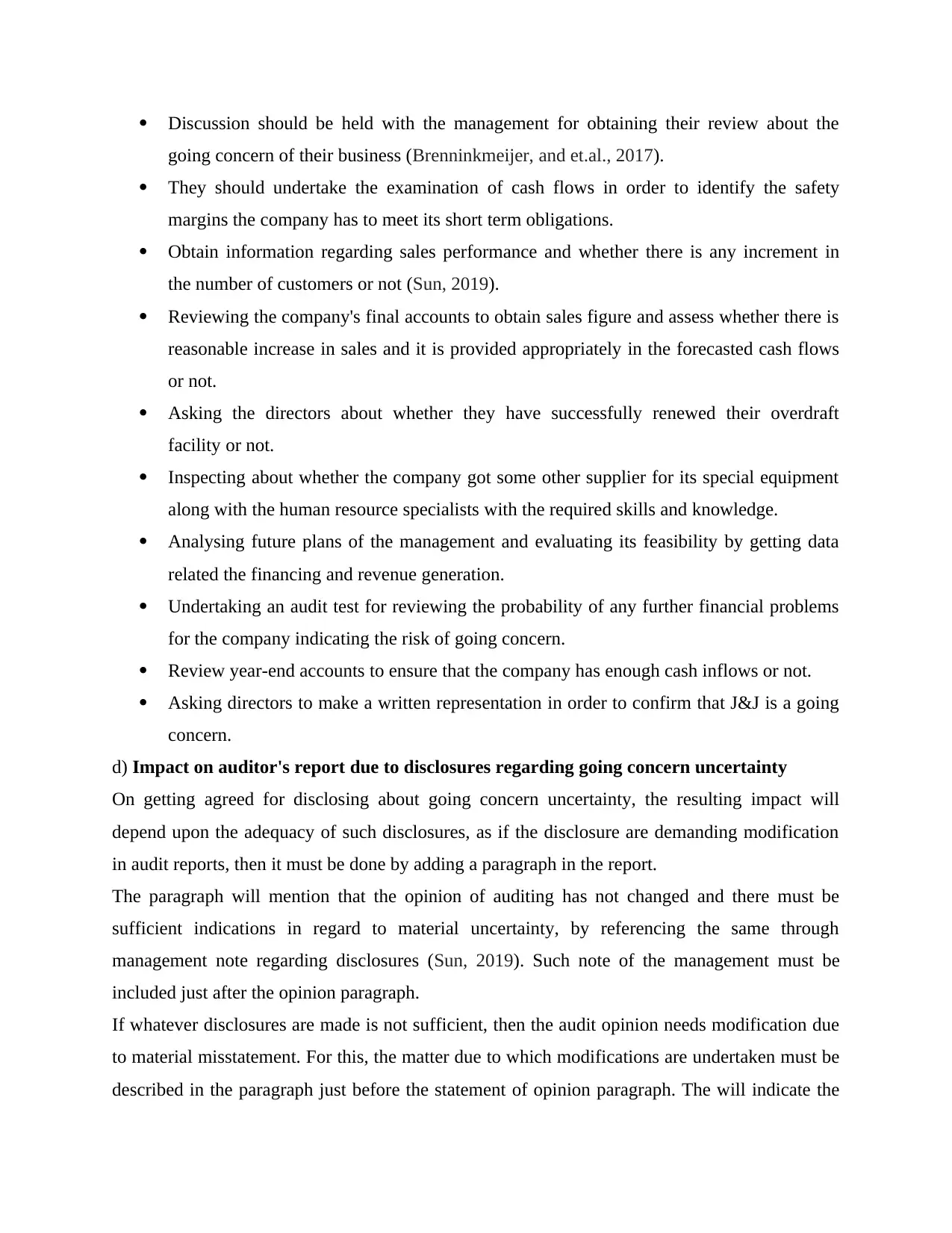
Discussion should be held with the management for obtaining their review about the
going concern of their business (Brenninkmeijer, and et.al., 2017).
They should undertake the examination of cash flows in order to identify the safety
margins the company has to meet its short term obligations.
Obtain information regarding sales performance and whether there is any increment in
the number of customers or not (Sun, 2019).
Reviewing the company's final accounts to obtain sales figure and assess whether there is
reasonable increase in sales and it is provided appropriately in the forecasted cash flows
or not.
Asking the directors about whether they have successfully renewed their overdraft
facility or not.
Inspecting about whether the company got some other supplier for its special equipment
along with the human resource specialists with the required skills and knowledge.
Analysing future plans of the management and evaluating its feasibility by getting data
related the financing and revenue generation.
Undertaking an audit test for reviewing the probability of any further financial problems
for the company indicating the risk of going concern.
Review year-end accounts to ensure that the company has enough cash inflows or not.
Asking directors to make a written representation in order to confirm that J&J is a going
concern.
d) Impact on auditor's report due to disclosures regarding going concern uncertainty
On getting agreed for disclosing about going concern uncertainty, the resulting impact will
depend upon the adequacy of such disclosures, as if the disclosure are demanding modification
in audit reports, then it must be done by adding a paragraph in the report.
The paragraph will mention that the opinion of auditing has not changed and there must be
sufficient indications in regard to material uncertainty, by referencing the same through
management note regarding disclosures (Sun, 2019). Such note of the management must be
included just after the opinion paragraph.
If whatever disclosures are made is not sufficient, then the audit opinion needs modification due
to material misstatement. For this, the matter due to which modifications are undertaken must be
described in the paragraph just before the statement of opinion paragraph. The will indicate the
going concern of their business (Brenninkmeijer, and et.al., 2017).
They should undertake the examination of cash flows in order to identify the safety
margins the company has to meet its short term obligations.
Obtain information regarding sales performance and whether there is any increment in
the number of customers or not (Sun, 2019).
Reviewing the company's final accounts to obtain sales figure and assess whether there is
reasonable increase in sales and it is provided appropriately in the forecasted cash flows
or not.
Asking the directors about whether they have successfully renewed their overdraft
facility or not.
Inspecting about whether the company got some other supplier for its special equipment
along with the human resource specialists with the required skills and knowledge.
Analysing future plans of the management and evaluating its feasibility by getting data
related the financing and revenue generation.
Undertaking an audit test for reviewing the probability of any further financial problems
for the company indicating the risk of going concern.
Review year-end accounts to ensure that the company has enough cash inflows or not.
Asking directors to make a written representation in order to confirm that J&J is a going
concern.
d) Impact on auditor's report due to disclosures regarding going concern uncertainty
On getting agreed for disclosing about going concern uncertainty, the resulting impact will
depend upon the adequacy of such disclosures, as if the disclosure are demanding modification
in audit reports, then it must be done by adding a paragraph in the report.
The paragraph will mention that the opinion of auditing has not changed and there must be
sufficient indications in regard to material uncertainty, by referencing the same through
management note regarding disclosures (Sun, 2019). Such note of the management must be
included just after the opinion paragraph.
If whatever disclosures are made is not sufficient, then the audit opinion needs modification due
to material misstatement. For this, the matter due to which modifications are undertaken must be
described in the paragraph just before the statement of opinion paragraph. The will indicate the
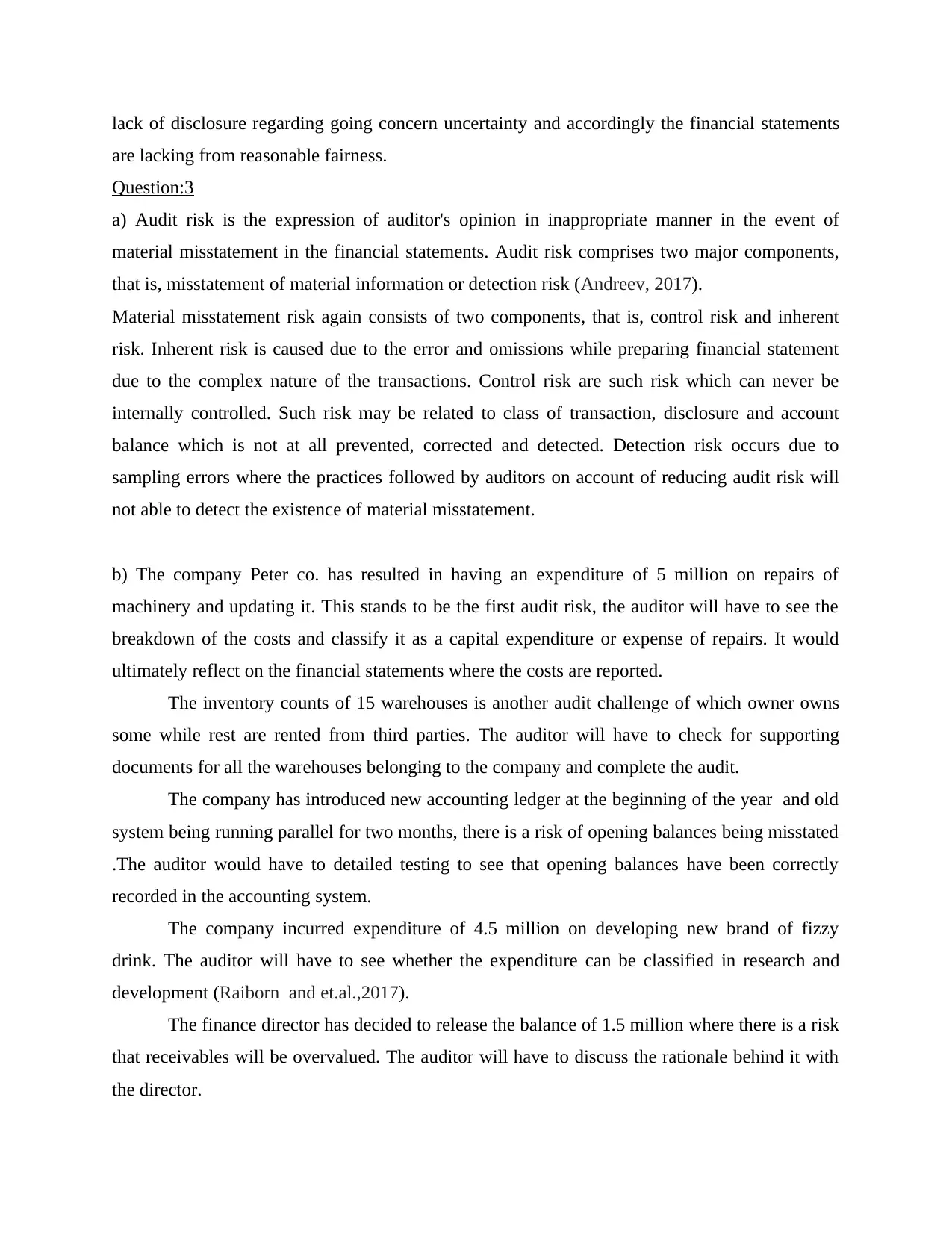
lack of disclosure regarding going concern uncertainty and accordingly the financial statements
are lacking from reasonable fairness.
Question:3
a) Audit risk is the expression of auditor's opinion in inappropriate manner in the event of
material misstatement in the financial statements. Audit risk comprises two major components,
that is, misstatement of material information or detection risk (Andreev, 2017).
Material misstatement risk again consists of two components, that is, control risk and inherent
risk. Inherent risk is caused due to the error and omissions while preparing financial statement
due to the complex nature of the transactions. Control risk are such risk which can never be
internally controlled. Such risk may be related to class of transaction, disclosure and account
balance which is not at all prevented, corrected and detected. Detection risk occurs due to
sampling errors where the practices followed by auditors on account of reducing audit risk will
not able to detect the existence of material misstatement.
b) The company Peter co. has resulted in having an expenditure of 5 million on repairs of
machinery and updating it. This stands to be the first audit risk, the auditor will have to see the
breakdown of the costs and classify it as a capital expenditure or expense of repairs. It would
ultimately reflect on the financial statements where the costs are reported.
The inventory counts of 15 warehouses is another audit challenge of which owner owns
some while rest are rented from third parties. The auditor will have to check for supporting
documents for all the warehouses belonging to the company and complete the audit.
The company has introduced new accounting ledger at the beginning of the year and old
system being running parallel for two months, there is a risk of opening balances being misstated
.The auditor would have to detailed testing to see that opening balances have been correctly
recorded in the accounting system.
The company incurred expenditure of 4.5 million on developing new brand of fizzy
drink. The auditor will have to see whether the expenditure can be classified in research and
development (Raiborn and et.al.,2017).
The finance director has decided to release the balance of 1.5 million where there is a risk
that receivables will be overvalued. The auditor will have to discuss the rationale behind it with
the director.
are lacking from reasonable fairness.
Question:3
a) Audit risk is the expression of auditor's opinion in inappropriate manner in the event of
material misstatement in the financial statements. Audit risk comprises two major components,
that is, misstatement of material information or detection risk (Andreev, 2017).
Material misstatement risk again consists of two components, that is, control risk and inherent
risk. Inherent risk is caused due to the error and omissions while preparing financial statement
due to the complex nature of the transactions. Control risk are such risk which can never be
internally controlled. Such risk may be related to class of transaction, disclosure and account
balance which is not at all prevented, corrected and detected. Detection risk occurs due to
sampling errors where the practices followed by auditors on account of reducing audit risk will
not able to detect the existence of material misstatement.
b) The company Peter co. has resulted in having an expenditure of 5 million on repairs of
machinery and updating it. This stands to be the first audit risk, the auditor will have to see the
breakdown of the costs and classify it as a capital expenditure or expense of repairs. It would
ultimately reflect on the financial statements where the costs are reported.
The inventory counts of 15 warehouses is another audit challenge of which owner owns
some while rest are rented from third parties. The auditor will have to check for supporting
documents for all the warehouses belonging to the company and complete the audit.
The company has introduced new accounting ledger at the beginning of the year and old
system being running parallel for two months, there is a risk of opening balances being misstated
.The auditor would have to detailed testing to see that opening balances have been correctly
recorded in the accounting system.
The company incurred expenditure of 4.5 million on developing new brand of fizzy
drink. The auditor will have to see whether the expenditure can be classified in research and
development (Raiborn and et.al.,2017).
The finance director has decided to release the balance of 1.5 million where there is a risk
that receivables will be overvalued. The auditor will have to discuss the rationale behind it with
the director.
⊘ This is a preview!⊘
Do you want full access?
Subscribe today to unlock all pages.

Trusted by 1+ million students worldwide
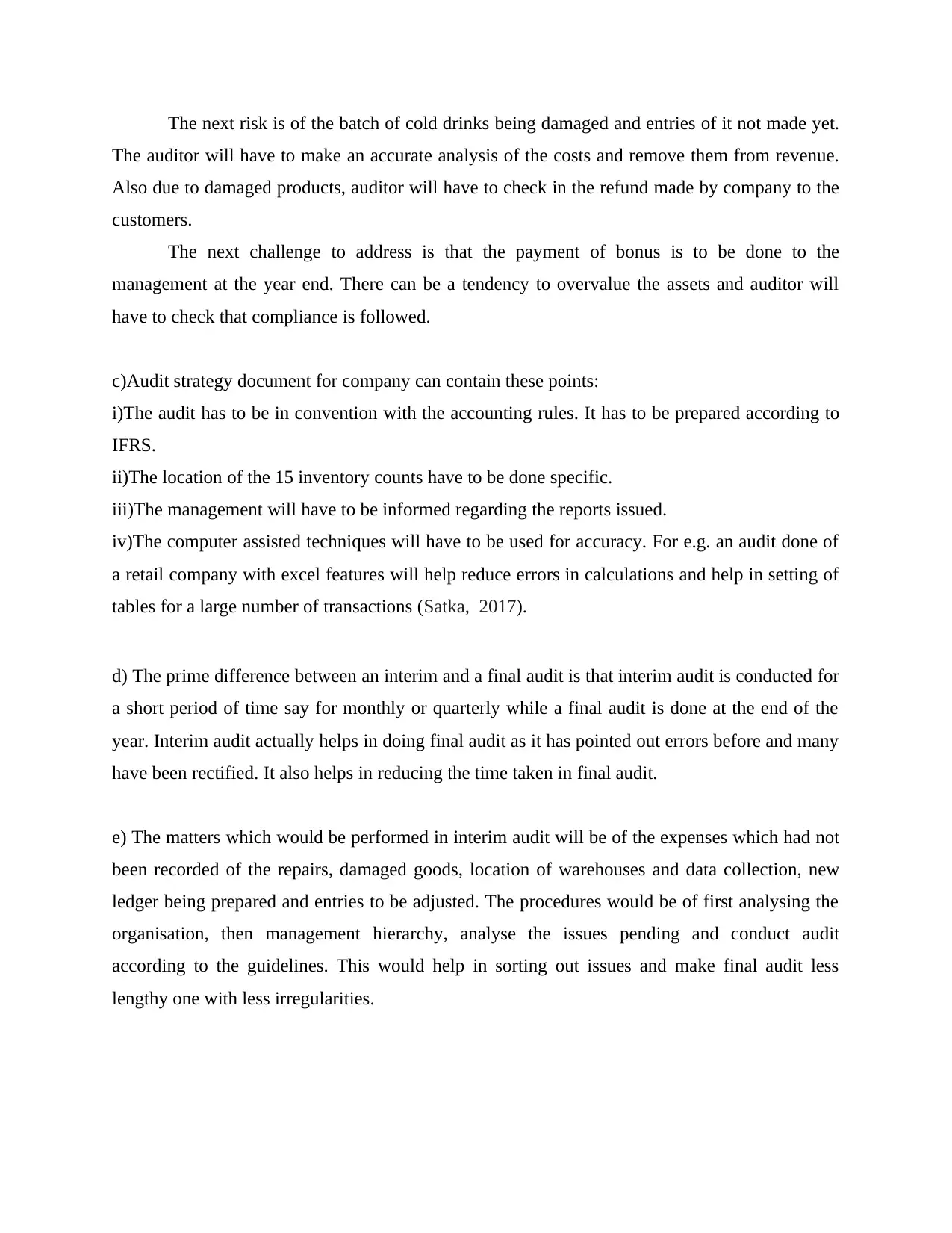
The next risk is of the batch of cold drinks being damaged and entries of it not made yet.
The auditor will have to make an accurate analysis of the costs and remove them from revenue.
Also due to damaged products, auditor will have to check in the refund made by company to the
customers.
The next challenge to address is that the payment of bonus is to be done to the
management at the year end. There can be a tendency to overvalue the assets and auditor will
have to check that compliance is followed.
c)Audit strategy document for company can contain these points:
i)The audit has to be in convention with the accounting rules. It has to be prepared according to
IFRS.
ii)The location of the 15 inventory counts have to be done specific.
iii)The management will have to be informed regarding the reports issued.
iv)The computer assisted techniques will have to be used for accuracy. For e.g. an audit done of
a retail company with excel features will help reduce errors in calculations and help in setting of
tables for a large number of transactions (Satka, 2017).
d) The prime difference between an interim and a final audit is that interim audit is conducted for
a short period of time say for monthly or quarterly while a final audit is done at the end of the
year. Interim audit actually helps in doing final audit as it has pointed out errors before and many
have been rectified. It also helps in reducing the time taken in final audit.
e) The matters which would be performed in interim audit will be of the expenses which had not
been recorded of the repairs, damaged goods, location of warehouses and data collection, new
ledger being prepared and entries to be adjusted. The procedures would be of first analysing the
organisation, then management hierarchy, analyse the issues pending and conduct audit
according to the guidelines. This would help in sorting out issues and make final audit less
lengthy one with less irregularities.
The auditor will have to make an accurate analysis of the costs and remove them from revenue.
Also due to damaged products, auditor will have to check in the refund made by company to the
customers.
The next challenge to address is that the payment of bonus is to be done to the
management at the year end. There can be a tendency to overvalue the assets and auditor will
have to check that compliance is followed.
c)Audit strategy document for company can contain these points:
i)The audit has to be in convention with the accounting rules. It has to be prepared according to
IFRS.
ii)The location of the 15 inventory counts have to be done specific.
iii)The management will have to be informed regarding the reports issued.
iv)The computer assisted techniques will have to be used for accuracy. For e.g. an audit done of
a retail company with excel features will help reduce errors in calculations and help in setting of
tables for a large number of transactions (Satka, 2017).
d) The prime difference between an interim and a final audit is that interim audit is conducted for
a short period of time say for monthly or quarterly while a final audit is done at the end of the
year. Interim audit actually helps in doing final audit as it has pointed out errors before and many
have been rectified. It also helps in reducing the time taken in final audit.
e) The matters which would be performed in interim audit will be of the expenses which had not
been recorded of the repairs, damaged goods, location of warehouses and data collection, new
ledger being prepared and entries to be adjusted. The procedures would be of first analysing the
organisation, then management hierarchy, analyse the issues pending and conduct audit
according to the guidelines. This would help in sorting out issues and make final audit less
lengthy one with less irregularities.
Paraphrase This Document
Need a fresh take? Get an instant paraphrase of this document with our AI Paraphraser
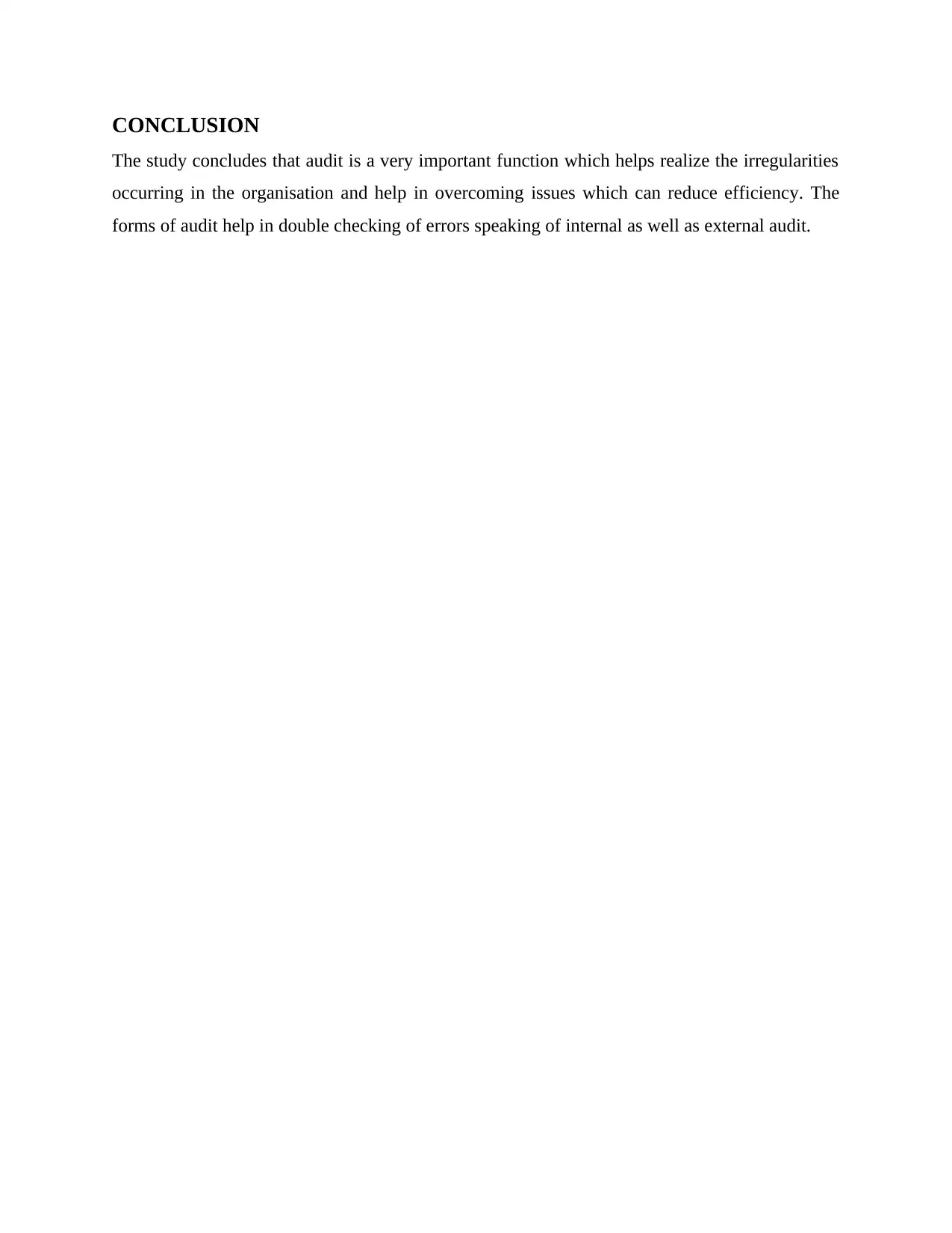
CONCLUSION
The study concludes that audit is a very important function which helps realize the irregularities
occurring in the organisation and help in overcoming issues which can reduce efficiency. The
forms of audit help in double checking of errors speaking of internal as well as external audit.
The study concludes that audit is a very important function which helps realize the irregularities
occurring in the organisation and help in overcoming issues which can reduce efficiency. The
forms of audit help in double checking of errors speaking of internal as well as external audit.
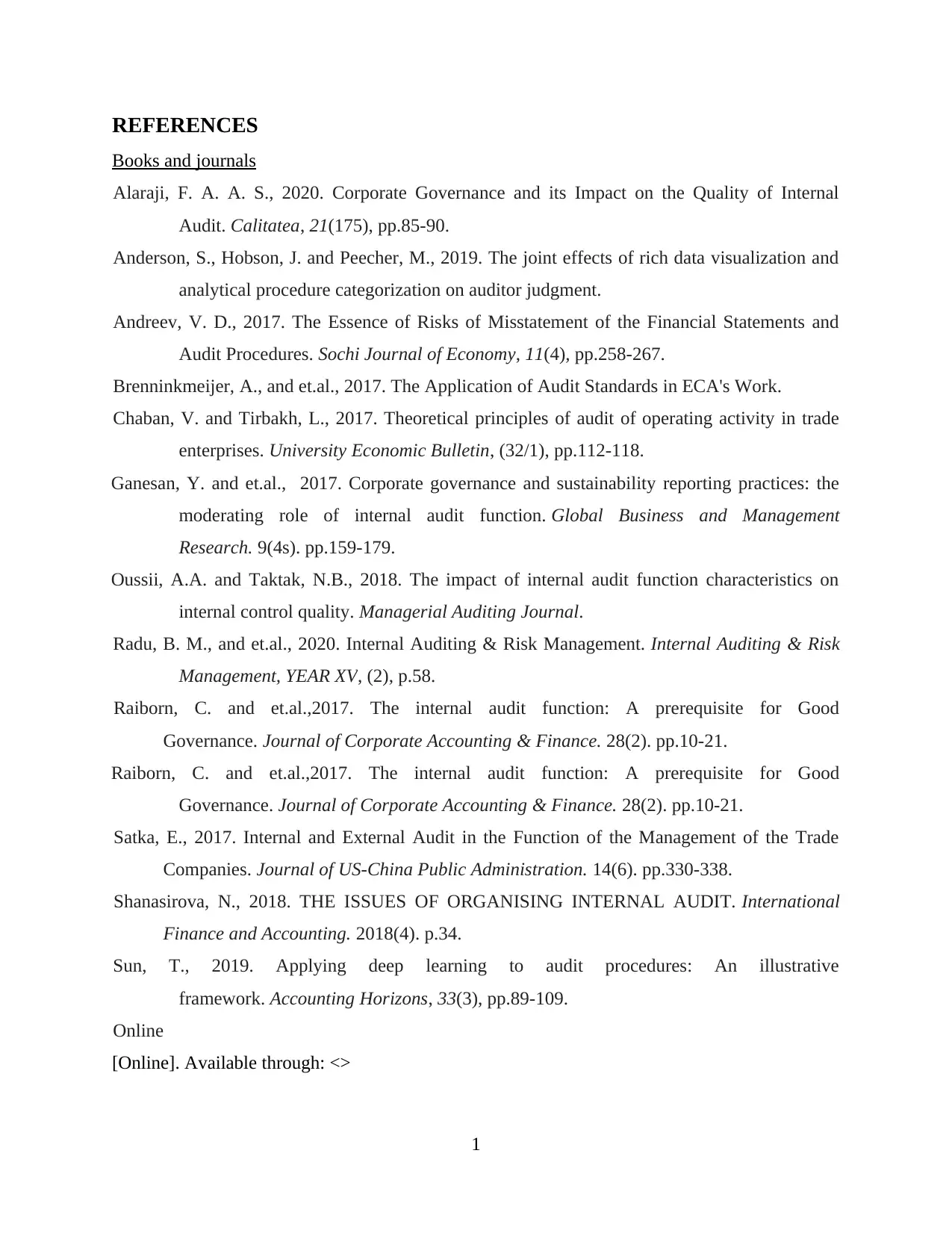
REFERENCES
Books and journals
Alaraji, F. A. A. S., 2020. Corporate Governance and its Impact on the Quality of Internal
Audit. Calitatea, 21(175), pp.85-90.
Anderson, S., Hobson, J. and Peecher, M., 2019. The joint effects of rich data visualization and
analytical procedure categorization on auditor judgment.
Andreev, V. D., 2017. The Essence of Risks of Misstatement of the Financial Statements and
Audit Procedures. Sochi Journal of Economy, 11(4), pp.258-267.
Brenninkmeijer, A., and et.al., 2017. The Application of Audit Standards in ECA's Work.
Chaban, V. and Tirbakh, L., 2017. Theoretical principles of audit of operating activity in trade
enterprises. University Economic Bulletin, (32/1), pp.112-118.
Ganesan, Y. and et.al., 2017. Corporate governance and sustainability reporting practices: the
moderating role of internal audit function. Global Business and Management
Research. 9(4s). pp.159-179.
Oussii, A.A. and Taktak, N.B., 2018. The impact of internal audit function characteristics on
internal control quality. Managerial Auditing Journal.
Radu, B. M., and et.al., 2020. Internal Auditing & Risk Management. Internal Auditing & Risk
Management, YEAR XV, (2), p.58.
Raiborn, C. and et.al.,2017. The internal audit function: A prerequisite for Good
Governance. Journal of Corporate Accounting & Finance. 28(2). pp.10-21.
Raiborn, C. and et.al.,2017. The internal audit function: A prerequisite for Good
Governance. Journal of Corporate Accounting & Finance. 28(2). pp.10-21.
Satka, E., 2017. Internal and External Audit in the Function of the Management of the Trade
Companies. Journal of US-China Public Administration. 14(6). pp.330-338.
Shanasirova, N., 2018. THE ISSUES OF ORGANISING INTERNAL AUDIT. International
Finance and Accounting. 2018(4). p.34.
Sun, T., 2019. Applying deep learning to audit procedures: An illustrative
framework. Accounting Horizons, 33(3), pp.89-109.
Online
[Online]. Available through: <>
1
Books and journals
Alaraji, F. A. A. S., 2020. Corporate Governance and its Impact on the Quality of Internal
Audit. Calitatea, 21(175), pp.85-90.
Anderson, S., Hobson, J. and Peecher, M., 2019. The joint effects of rich data visualization and
analytical procedure categorization on auditor judgment.
Andreev, V. D., 2017. The Essence of Risks of Misstatement of the Financial Statements and
Audit Procedures. Sochi Journal of Economy, 11(4), pp.258-267.
Brenninkmeijer, A., and et.al., 2017. The Application of Audit Standards in ECA's Work.
Chaban, V. and Tirbakh, L., 2017. Theoretical principles of audit of operating activity in trade
enterprises. University Economic Bulletin, (32/1), pp.112-118.
Ganesan, Y. and et.al., 2017. Corporate governance and sustainability reporting practices: the
moderating role of internal audit function. Global Business and Management
Research. 9(4s). pp.159-179.
Oussii, A.A. and Taktak, N.B., 2018. The impact of internal audit function characteristics on
internal control quality. Managerial Auditing Journal.
Radu, B. M., and et.al., 2020. Internal Auditing & Risk Management. Internal Auditing & Risk
Management, YEAR XV, (2), p.58.
Raiborn, C. and et.al.,2017. The internal audit function: A prerequisite for Good
Governance. Journal of Corporate Accounting & Finance. 28(2). pp.10-21.
Raiborn, C. and et.al.,2017. The internal audit function: A prerequisite for Good
Governance. Journal of Corporate Accounting & Finance. 28(2). pp.10-21.
Satka, E., 2017. Internal and External Audit in the Function of the Management of the Trade
Companies. Journal of US-China Public Administration. 14(6). pp.330-338.
Shanasirova, N., 2018. THE ISSUES OF ORGANISING INTERNAL AUDIT. International
Finance and Accounting. 2018(4). p.34.
Sun, T., 2019. Applying deep learning to audit procedures: An illustrative
framework. Accounting Horizons, 33(3), pp.89-109.
Online
[Online]. Available through: <>
1
⊘ This is a preview!⊘
Do you want full access?
Subscribe today to unlock all pages.

Trusted by 1+ million students worldwide
1 out of 13
Related Documents
Your All-in-One AI-Powered Toolkit for Academic Success.
+13062052269
info@desklib.com
Available 24*7 on WhatsApp / Email
![[object Object]](/_next/static/media/star-bottom.7253800d.svg)
Unlock your academic potential
Copyright © 2020–2025 A2Z Services. All Rights Reserved. Developed and managed by ZUCOL.




